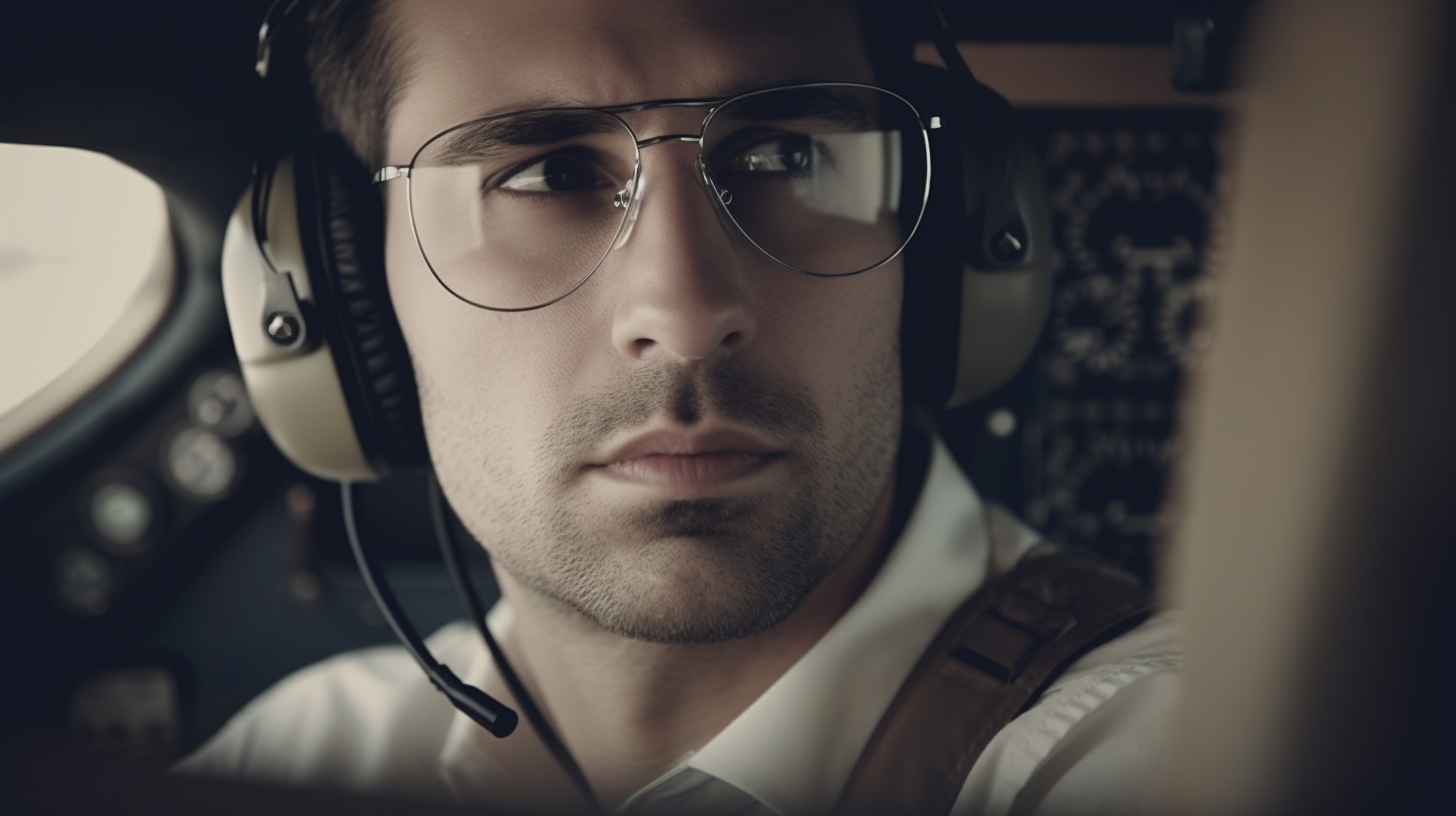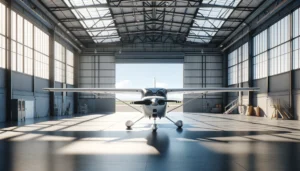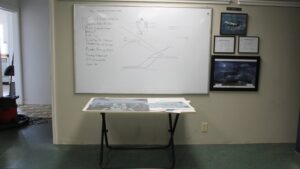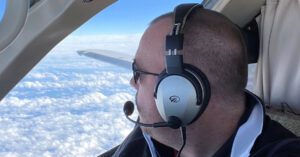Can You Be A Pilot With Glasses?

Yes, you can be a pilot with glasses. In the United States are many pilot schools where you can receive any level of pilot license while wearing glasses. Many pilots in the aviation sector rely on glasses to meet the visual acuity criteria required for a pilot license.
The essential fact is that people must meet all standards, and a pilot’s vision can attain the required 20/20 standard. This standard allows pilots to perform their tasks safely and effectively during their time in a flight academy and beyond.
Therefore, if you’ve been delaying your ambition of becoming a pilot because you need a better vision, you can and should reconsider. Wearing glasses will enable you to meet the requirements and successfully achieve your pilot license.
Aviation is a fascinating world full of meticulousness, rigor, and a fair share of misconceptions. One common misconception is that pilots must have perfect vision.
This essay seeks to dispel this myth by bringing light to the actual visual needs of pilots. It is critical to recognize that while good vision is essential, it does not have to be perfect.
Many pilots use corrective lenses and glasses to fly through the sky, indicating that vision impairments are not an insurmountable barrier in this career.
The purpose is to provide clarity and confidence to potential aviators whose poor vision may put them off.
Can colorblind people be pilots?
In life’s entertaining spectacle, many dreams of soaring through the skies as pilots. But for colorblind individuals, a unique set of challenges could alter this flight path. Yes, colorblind people can become pilots, but it’s not without difficulty. Certain color vision deficiencies might limit the types of aviation certificates they can obtain.
Flight school applicants are usually required to pass a color vision test as part of the FAA medical certification process. This ensures pilots can recognize different color signals crucial for safe flight. However, if they fail the standard test, alternative tests are available.
Some may even qualify for a Statement of Demonstrated Ability (SODA), effectively a waiver for colorblind pilots.
Emotions can run high in this process, a complex dance of hope, determination, and courage. The sky might not yield easily, but the triumphant echo of success when a colorblind person finally takes flight makes the struggle worth it.
Can You Be a Pilot with Bad Eyesight?
Of course, you can be a pilot with bad eyesight as long as you meet vision requirements. Many pilots use glasses or contact lenses to meet vision requirements and navigate the skies. The important thing is that the vision is correctable to 20/20.
Contrary to popular opinion, poor vision only allows students to become pilots. The aviation industry is more accommodating than most people realize.
Depending on the type of flying, vision requirements may differ. A commercial airline pilot or a bush pilot, for example, may have different standards than a private pilot.
The duration of training often allows students to understand these requirements and make necessary adjustments fully.
But, in the end, don’t let poor vision discourage you from pursuing an aviation career. The requirements are there to ensure safety while flying, and with today’s corrective measures, many prospective pilots can meet these vision requirements.
Do Pilots Need To Have Perfect 20/20 Vision?
The requirement for a 20/20 vision in aviation is crucial. Aviators must read small details on the instrument panel, spot distant landmarks and identify other aircraft that may appear as specks. This sharp vision is essential for safety and precision in the skies.
However, 20/20 vision doesn’t mean ‘perfect’ vision, but what an average person can see clearly at 20 feet. If an aviator’s natural vision isn’t 20/20, they can still meet this standard with corrective measures like contact lenses or refractive surgery.
While at a flight academy, individuals aspiring to become aviators learn about these standards and potential corrective measures. This duration at the academy is an important time for prospective pilots to understand and adapt to the requirements of aviation vision standards.
Can Pilots Have Contact Lenses?
Pilots can wear contact lenses, and they are frequently favored in the cockpit because of their convenience and larger field of view compared to glasses. They remove the risk of glasses falling off during vital flight maneuvers.
Refractive operations, including LASIK and PRK (1), have acquired recognition in the aviation sector and spectacles and contact lenses. Because these operations can effectively repair a wide range of vision disorders, they are a feasible alternative for many people.
However, like any medical procedure, comprehensive study and consultation with healthcare professionals are required before deciding. This step ensures that these surgeries’ possible risks, benefits, and recovery timeframes are understood.
What Vision Do You Need to Be a Fighter Pilot?
Fighter pilots, especially those in the air force, have demanding eyesight needs and are traditionally expected to have natural 20/20 vision(2).
Why is that? This demand is because military aviation requirements often exceed those of civilian flying. People who wear glasses can be air force pilots, too, as they must make split-second decisions while flying at high speeds and under intense physical stress.
They must identify hostile aircraft and ground targets from a distance, sometimes in unfavorable weather conditions.
Eyeglasses or corrective surgery are permitted in some military branches, recognizing that these methods can provide necessary vision correction without compromising safety or performance.
In the end, people who wear glasses can be air force pilots.
Key Requirements for Securing a Medical Certificate as a Pilot
Pilot vision standards vary greatly depending on the type of pilot license and the regulating aviation authority.
For instance, the Federal Aviation Administration (FAA) in the United States has different vision requirements for first-class airline transport pilots, second-class commercial pilots, and third-class private pilots.
Obtaining a pilot license requires a complete medical checkup, which includes a specific eye test. The guide to learning these requirements is often provided by the flight academy you choose.
Regardless of whether a pilot wears glasses or not, this process is critical to ensure they can safely perform their duties.
It exemplifies the aviation industry’s commitment to safety, taking every precaution to ensure that pilots can navigate the skies without endangering themselves or their passengers.
Book In An Eye Test If You Have Concerns
Schedule an eye exam if you’re an aspiring pilot with vision difficulties. An optometrist can evaluate your vision and recommend any corrective measures. They can also help you better understand your eye health and vision abilities.
Regular eye exams are for more than just people who do not have good vision. They are essential for all pilots. After all, our eyes are our most critical cockpit tools, and we must take good care of them.
For those aspiring pilots who wear glasses, it’s important to remember that your vision should not be a roadblock on your path to the skies.
A successful aviation career is within your grasp with the right corrective measures, such as well-fitted glasses or contact lenses, and a commitment to meet the necessary vision standards.
Every pilot’s journey begins with a dream of flight. Don’t let your glasses be perceived as a hindrance. Instead, view them as an essential tool that empowers you to achieve your goal of becoming a pilot. Your bad vision is not a limitation but a means to unlock your potential and soar high in aviation.
Real-life Stories of Pilots with Glasses
There are countless inspiring instances of pilots who have achieved remarkable success despite requiring glasses. Consider the story of a pilot who was informed as a child that his vision would end his flying aspirations.
Undaunted, he proudly wore his glasses and ascended through the ranks to become a successful airline captain.
Then there’s the story of a nearsighted female pilot who never allowed her vision to get in the way of her dreams. She pursued her dream with tenacity and became respected at a major airline while still wearing her spectacles.
These are more than simply anecdotes; they are convincing demonstrations that wearing glasses is not a hindrance to a successful career in aviation.
They highlight the persistence, resilience, and enthusiasm of those who refuse to allow their vision problems to keep them from pursuing their aspirations.
These pilots act as role models, proving that the sky is the limit with the appropriate mindset and remedial steps.
Wrapping up
The key point to remember is that these requirements stipulate vision must be correctable to 20/20, not that it must be naturally perfect.
With the aid of corrective lenses or even refractive surgery, many vision impairments can be effectively managed, enabling individuals to meet the necessary vision standards.
So, for those with less-than-perfect vision, remember that your dreams of flying are far from grounded.
The sky is not a limit but a vast expanse of opportunity waiting to be explored.
FAQ´S
Why Are There Eyesight Requirements for Pilots?
Eyesight requirements for pilots exist because they’re responsible for numerous lives and expensive machinery. Navigating often challenging conditions, they must possess clear vision for tasks like interpreting instrument panels, identifying landmarks, and recognizing other aircraft. Clear vision is also pivotal during emergencies. These requirements ensure that every pilot can optimally perform their duties, contributing to aviation safety. Thus, these standards are not just about individual competence but also about the collective safety of passengers, crew, and people on the ground.
Can You Be A Commercial Pilot With Bad Eyesight?
Yes, you can be a commercial pilot with less-than-perfect eyesight. However, your vision must be correctable to 20/20 with glasses or contact lenses, according to Federal Aviation Administration (FAA) standards. Uncorrected vision can be worse but still must meet certain limits. Different jurisdictions may have varying standards, and some conditions like color blindness could pose challenges.
Can You Be A Pilot With Color Blindness?
Yes, you can be a pilot with color blindness, but there may be restrictions. Color vision is crucial in aviation for tasks such as reading cockpit instruments, recognizing signal lights, and distinguishing terrain. If you fail the color vision test during the medical examination, you might be limited to daytime flying or be restricted from certain types of aviation careers.
Can Pilots Get Lasik?
Yes, pilots can get Lasik eye surgery. The Federal Aviation Administration (FAA) permits pilots to undergo refractive surgeries like Lasik to correct their vision. However, post-surgery, they must demonstrate that their vision is stable, and there are no harmful side effects like glare or halos. After the procedure, pilots must go through a mandatory waiting period to ensure stability of vision before they can return to flying.
In the United States, aspiring pilots can pursue a pilot license even if they wear glasses. Many pilots in the aviation industry rely on glasses to meet the required visual acuity standards for obtaining a pilot license.
Pilots can have bad eyesight and still pursue a career in aviation as long as they meet the necessary vision requirements.
It is possible for colorblind people to become pilots, they may encounter limitations in the types of aviation certificates they can acquire due to their color vision deficiencies.






